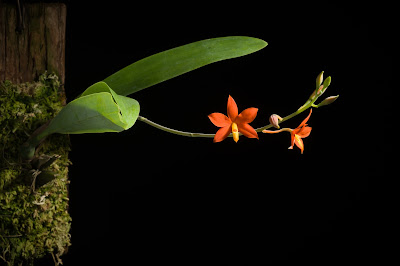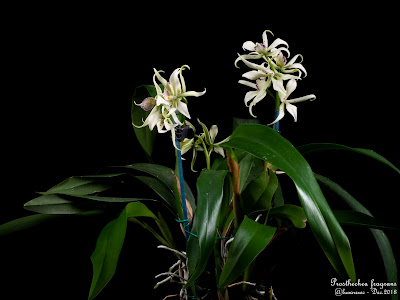Prosthechea - Appendage orchid flowers are usually non-resupinate with sepals and petals that are free, spreading and usually subequal. The lip is...
Prosthechea, also called as Appendage orchid, Anacheilium, Epicladium, Epithecia, Euchile, Hormidium, Panarica, Pollardia, Pseudencyclia, is a genus in the Orchidaceae family. This genus was described by George Beauchamp Knowles and Frederic Westcott in 1838.
DESCRIPTION OF PROSTHECHEA - APPENDAGE ORCHID
Prosthechea is native to Southern Florida, Mexico to Tropical America. It is found growing on trees or rocks in forests in Bahamas, Belize, Bolivia, Brazil North, Brazil Northeast, Brazil South, Brazil Southeast, Brazil West-Central, Cayman Is., Colombia, Costa Rica, Cuba, Dominican Republic, Ecuador, El Salvador, Florida, French Guiana, Guatemala, Guyana, Haiti, Honduras, Jamaica, Leeward Is., Mexico Central, Mexico Gulf, Mexico Northeast, Mexico Northwest, Mexico Southeast, Mexico Southwest, Nicaragua, Panamá, Paraguay, Peru, Puerto Rico, Suriname, Trinidad-Tobago, Venezuela, Venezuelan Antilles, Windward Is.
The plants of this genus are epiphytic to lithophytic species with spindle-shaped, often flattened pseudobulbs. The leaves are 1-5, thin, leathery, ovate to lanceolate.
Appendage orchid blooms usually once a year on the scapose or sessile inflorescene with prominent spathe. The flowers are usually non-resupinate with sepals and petals that are free, spreading and usually subequal. The lip is pressed closely to half of the column and shows a callus. The column is 3- to 5-toothed at its top and carrying four hard pollina attached to the caudicles.
PROSTHECHEA - APPENDAGE ORCHID CARE AND CULTURE
Cultural information should only be used as a guide, and should be to be adapted to suit you. Your physical location; where you grow your plants, how much time you have to devote to their care, and many other factors, will need to be taken into account. Only then can you decide on the cultural methods that best suit you and your plants.
Light:
Prosthechea needs a light level of 25000-35000 lux. The light should be filtered or diffused and the plants should not be exposed to direct midday sun. Strong air movement should be provided all the time.
Temperature:
These plants grow well in intermediate temperature. In summer, the average day temperature is 24-27 °C, and the night 14-16 °C, with a daily amplitude of 8-10 °C. In winter the average daytime temperatures are 23-25 °C, and 13-15 °C during the night, while the daily amplitude is 8-11 °C.
Humidity:
Appendage orchid needs the humidity of 80% in the period of growth, in winter and spring it falls to 60-70%. Too dry air has a negative effect on the development of the plant: its growth is inhibited, and the leaves begin to turn yellow and dry out. The higher temperature, the higher the humidity should be, and the higher the humidity, the more often and longer it is necessary to ventilate the room where the plants are contained, otherwise the probability of rotting and various kinds of fungal diseases. Good air movement is essential while the plants are in leaf and growing.
Substrate, growing media and repotting:
Prosthechea are most often grown in pots or baskets with a very thick, loose and well-drained substrate. There should be plenty of space in the pots to allow the roots to dry quickly after watering. It is recommended to use smaller pots sufficient for only one or two years of growth, because the substrate in larger pots remains wet after watering for too long. Roots that do not dry out quickly enough after watering rot. Most growers recommend medium grain bark, though others prefer medium cork pieces mixed with large lumps of charcoal.
The plants also grow well mounted on tree-fern or cork rootstocks, provided that high humidity is ensured. Fixed plants require high humidity and at least daily watering in summer, and in the case of dry and hot weather, it may be necessary to water several times a day.
Transplanting or splitting is best done when new roots begin to emerge, or immediately after blooming. This allows the plants to acclimate in a relatively short time and provides them with the least stress.
Watering:
The plants should be watered abundantly during active growth, but their roots must dry out quickly after watering. At the end of autumn, the amount of water should be gradually reduced.
Fertilizer:
Appendage orchid should be fertilized every week 1/4-1/2 of the recommended dose of fertilizer for orchids. A fertilizer with a high nitrogen content is beneficial from spring to mid-summer, and a phosphorus-rich fertilizer can be used in late summer and autumn. Higher phosphorus content stimulates better flowering in the next season and promotes hardening of new growth before winter.
To avoid the accumulation of mineral deposits during periods of strong fertilization, it is recommended to rinse the containers approximately every month.
Rest period:
In winter, allow the plants to dry a bit before the next watering, but do not let the remaining ones dry for long periods of time. In most cases, light watering every 2-3 weeks and occasional morning misting between waterings are sufficient. Fertilization should be limited or should be abandoned altogether until spring, when stronger watering resumes.
BUY PROSTHECHEA - APPENDAGE ORCHID AND RELATED PRODUCTS
SOME SPECIES AND VARIETIES OF PROSTHECHEA WITH CARE TIPS
- Prosthechea baculus - Stake-Like Prosthechea
- Prosthechea brassavolae - Brassavola-Like Prosthechea
- Prosthechea chacaoensis - Chacao Prosthechea
- Prosthechea chondylobulbon - Cone-Like Bulb Prosthechea
- Prosthechea cochleata - Cockleshell Orchid - Octopus Orchid - Black Orchid
- Prosthechea fragrans - Fragrant Prosthechea
- Prosthechea livida - Bluish Prosthechea
- Prosthechea micropus
- Prosthechea ochracea - Ochre Yellow Prosthechea
- Prosthechea prismatocarpa - Prism-Shaped Seedpod Prosthechea
- Prosthechea pterocarpa - Winged Seedpod Prosthechea
- Prosthechea pygmaea - Dwarf Prosthechea - Dwarf butterfly orchid
- Prosthechea radiata - Lined Petal Orchid
- Prosthechea rhynchophora - Beak-Carrying Prosthechea
- Prosthechea semiaperta - Half-Open Prosthechea
- Prosthechea vespa - Wasp Prosthechea
- Prosthechea vitellina - Yolk-Yellow Prosthechea















COMMENTS